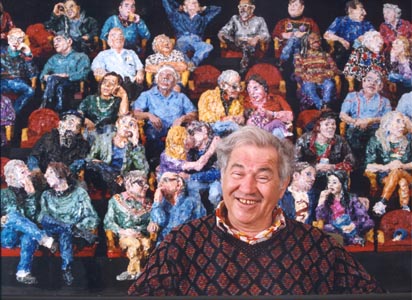Adolph's Balcony
by Suzanne Rosenblatt
Yesterday Adolph said, as he ran out to a matinee, "There's nothing I like better than going to the movies," and it struck me that that's why he's spent the past two years putting his friends and relatives into the balcony. He intended to sculpt twenty five to thirty figures, but once he started, he kept running into people he wanted to include. Last time I checked, there were more than eighty of us waiting for the film to begin.
He talked about the piece for years. He actually started it in August of 1996 when his cousins, Ada and Avrahm, visited from Israel, and he realized that if he didn't sculpt them then, he might never. They posed as a couple, outside near our garden. While Adolph sculpted Avrahm, Ada and I staked tomato plants; when he sculpted Ada, Avrahm and I went for a bike ride. When he worked on both of them simultaneously, I videotaped the process. The whole event demonstrates one of those funny little facts of Adolph's art: no one in Adolph's balcony posed in a theater, just as no one at his Oriental Pharmacy Lunch Counter posed in the drugstore. Most sat in Adolph's studio, not in our garden, and chatted with him as he humanized a thirty-pound chunk of clay.
Beginning with Avrahm and Ada was pivotal, for it was a reminder that people usually go to the movies in pairs. Adolph thought in those terms when doing the rest of the piece: he asked people to pose with spouse or child or lover so he could get their relationship to each other. And he went out of his way to find a few people willing to pose in a two or three hour kiss.
Models sat for the clay image, then the sculpture was fired, and finally the models returned to the studio several months later, either wearing or carrying the clothes they wore the first time round, for Adolph to paint them.
At one point Adolph realized something was missing: he wasn't in his own movie house. Since he hated the
glassy-eyed stare
of self portraits, he asked Narendra Patel to sculpt him. Adolph never sculpts sitting down nor watches movies standing up; to sculpt himself he'd have to do a bit of a dance: sit posing, stand sculpting. He does a bit of a dance, anyway, peers at his subject, gets close, walks around him or her, keeps up a steady stream of conversation, turns sculpting into performance art. (See Adolph at work) And he transmits all that energy to the piece, which becomes as alive as clay can become. For he's not trying to get an exact image of his model, he's trying to get an alive image, to capture the person's aura.
At first sight of the balcony, we're aware of the dazzling color that makes our eyes do their own dance, aware of an expectant crowd seated in five rows of red seats, and we sense the show will begin pretty soon. Then we realize that these are all particular individuals, each with a unique personality, wardrobe, gesture, attitude toward waiting. Some chat, some lean back, some lean forward, Liz nurses Maia, Martha squirms on Laure's lap, Pauline eats popcorn, Sarah P and Allan L kiss even before the lights are out. After you've looked at each person once, you realized that you want to look again, that a quick glance doesn't suffice.
Time and space set constraints on the size of the piece, and at last it's more or less finished. Of course figures can always be added or subtracted. Why not?






















